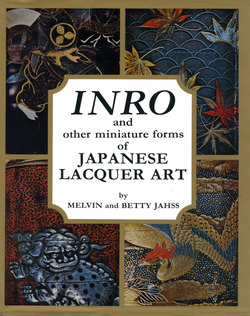Читать книгу Inro & Other Min. forms - Melvin Jahss - Страница 9
На сайте Литреса книга снята с продажи.
ОглавлениеIntroduction
WHEN JAPAN FINALLY OPENED HER DOORS TO THE OUTSIDE world in the mid-19th century, there emerged one of the most skillful, exquisite, and remarkable art forms ever developed by any country: that of Japanese lacquer. Today, it is startling to discover that what we now consider as avant-garde in modern art—such as abstraction, impressionism, and collage—had already been perfected by Japanese lacquer artists over 300 years ago.
Japanese art is best known for its superb craftsmanship as expressed through its three forms of miniature art, each created in a different medium. The first form and by far the most popular in the Western world is the netsuke. This is essentially a tiny sculptured wood or ivory figure. These exquisite carvings were made by a specialized class of artisans, a handful of whom are still carving to this very day. The second medium is that of miniature metal art, best expressed in sword ornamentation, such as the sword guard (tsuba) or knife handle (kozuka). This art form was also done by very specialized artists who unfortunately no longer exist because of the ban on wearing swords since 1877. The third medium equally prized by the Japanese is that of miniature lacquer art, also created by specialized artists. It should be noted that Oriental lacquer is not in the Western sense a chemically prepared varnish but is a natural product which comes from the sap of a tree. The lacquer is applied in numerous layers, and its beautiful gloss is only obtained through endless polishings. Furthermore, the magnificent designs are accomplished through painstaking applications of layers of repeated dustings of fine metallic and colored powders onto the tacky lacquered surfaces. The art of lacquering has also fallen into disuse because of the decreased demand, as well as the expense and extreme length of time necessary for its production.
Japanese lacquer work represents the acme of artistry as well as of technical craftsmanship. Such artistry embodies the Japanese sense of aesthetic and decorative design in a colorful graphic form, while the craftsmanship is expressed through the use of an extremely difficult medium in which to work. Thus while lacquer art was originally adopted from China, even the adept Chinese craftsmen were unable to copy the high, Japanese development of this medium.
Among the lacquered objects, the miniature pieces provided the greatest technical challenge, both in the difficulty of artistically presenting subject matter and design on relatively small irregularly shaped surface areas and in the miniature, almost microscopic, work entailed in such small objects. Of all the miniature lacquered objects the widely used inro is a perfect example of Japanese miniature lacquer art. This small bibelot, approximately 31/2" x 2" x 1" deep, was essentially a multicompartment case worn suspended from the sash and served to carry seals, portable shrines, or powdered medicines. Inro were developed during the late 17th and 18th centuries, paralleling the height of development of Japanese lacquer art. The Japanese people did not wear or use any nonutilitarian objects such as jewelry. Therefore the artisan only worked on utilitarian objects. The inro, besides the sword, was the one exposed object worn mainly by the noblemen, samurai (warrior class), and merchants. It thus became the one "jewel" and expressed artistically in miniature lacquer form the aesthetic tastes of its patrons as revealed through the creative talents of the great Japanese lacquer artists.
Since Japanese lacquer is an extremely difficult medium in which to work, it often took months or even years to complete a single object. However, under the old Japanese feudal system time and money were of no significance to the lacquerer as each daimyo, or lord, subsidized his own artists. Only under such circumstances was it possible to have so time-consuming and costly an art flourish and prosper. However by the mid-19th century there was an overthrow of the feudal system and the loss of the patrons of lacquer art. These factors, combined with the commercialization of Japanese art forms in general, virtually brought an end to this magnificent form of art.
It is the purpose of this book to elucidate the history, technique, and development of this unique art form, about which so little has been written and for which Japan has become world-renowned.
We are indebted to many people for their cooperation in the preparation of this book. We would particularly like to thank Mr. Joseph U. Seo for his invaluable assistance and guidance not only in the translating of original Japanese sources and for clarifying previously uncertain data relating to lacquer artists but also for his expert judgment in obtaining and assessing the major portion of the objects which are illustrated.
